Portfolio
Artist Statement
As a composer and visual artist, I work in a third space between the visual and the sonic to produce synesthetic, hybrid content. I developed a rubric that I call Trans-Sensing. Trans-Sensing Modalities are methods that trans people—specifically those who identify as transgender, but also people whose subjectivity is unmoored or unrecognizable to the dominant culture—intuitively cultivate to navigate the world. An emphasis on sensory presence and integration is part of the trans experience in explicit and nuanced ways, and in my work I evoke these synesthetic states of being.
I am interested in revealing the ways in which a trans subjectivity listens, discerns, and responds to the rigidity and assumptions of social systems and how this navigation requires a broadening of the perception of subjectivity beyond the solidified singular “real” self. Nuanced, integrated, perceptual sensing strategies are catalyzed by a need to decipher, decode, resonate, read, pass, and tune social systems and structures. While these hyper-sensing modalities may be forged from the threat of real or imagined harm, they can be claimed as powerful tools for re-tuning our bodies away from quick optical differentiations.
Vessel – An example of the Phenomenology of Resonance
My work synthesizes sound, visual content, sensory perception, the physical body, and objects. I create compositions, sculptures, videos, performances, installations, scores, photographs, recordings, and texts. In my studio, I leverage the knowledge of sound-based methodologies and fuse them with material research, fabrication, and visual aesthetics into a synesthetic cosmology. These variables lead me through the nuanced process of working through ideas which often begin as some sort of experiential information that I am trying to convey. Usually this feeling starts in my own body as it contends with social/political space. Usually this feeling begins with some sort of dissociation or gap that I am trying to work through.
I don’t believe that in my practice there is any discrete form or object that isn’t responding or has responded to a larger system. These series of interdependent relationships can be thought of through an idea of the phenomenology of resonance.
ENERGY CHARACTERS
Collaboration between Micah Silver and Jules Gimbrone
Heat lamps, brass, rubber hose, fan, air, audio.
Hammer Museum, Lifes, 2022

This composition of heat comes from our shared desire to elucidate the inherent fallacy of precision in quantifiable data as compared to the messy sensory membranes of the body in interpreting the feelings of energy transfer (sound, heat, movement, etc). What we desire most is invisible. In artworks, in people, in things, in ourselves. The visible is a way to grasp and luxuriate in our senses’ most tuned/acculturated interfaces into meaning, but the momentum of desire is invisible, as is the real of the object.
Trinities
Cohen Gallery, Brown University
November 4-December 19, 2021
Curator Kate Kraczon:
Jules Gimbrone’s immersive installations dissolve visual and aural binaries. Objects both sculptural and sonic reverberate across the space of the gallery, blending and bending light and sound into washes of color, tone, and tempo. Meticulously calibrated by the artist, these structures are intentionally scored to produce physical sensations that migrate—unfixed—across the senses.
Traps and Transmutations 3
Bortolami Gallery
2021
Jules Gimbrone’s Traps and Transmutations 3, 2021, is a resonating stage composed through a cosmology of vibrating actants and actors. The traps come in the appearance of static forms, recording mechanisms and quantifiable technologies. The transmutations are catalyzed by all of the forces pushing away from, cutting, degrading and liberating these forms. Sound, a form of energy transfer, literally pushes through the forms: knives, cast soap, microphones cast in resin, and desiccated cabbage. These forms are cast into vibratory ecstasy through a composition of audio including the artist’s breath blowing up a balloon, the recording of the motor of a fan, and a series of feedback exercises with the stage. The most explicit symbol of the body, a 5 ft resonating glass vessel is filled with salt water and other organic detritus is animated by the artist’s voice chanting the phrase “concave, convex” as a sort of transubstantiatory ritual.
At what point is a vibrating sack of molecules legible as an object? What makes it so and what are the forces that act upon it to assist or degrade this legibility? Is the convex curve of a hip enough to signify a gender? At what point does that curve become a symbol? Can we chart the precise moment of categorization? What are the possibilities if we can’t?
The Whole is Also a Hole
Walker Art Center
Resonance: A Sound Art Marathon
2019
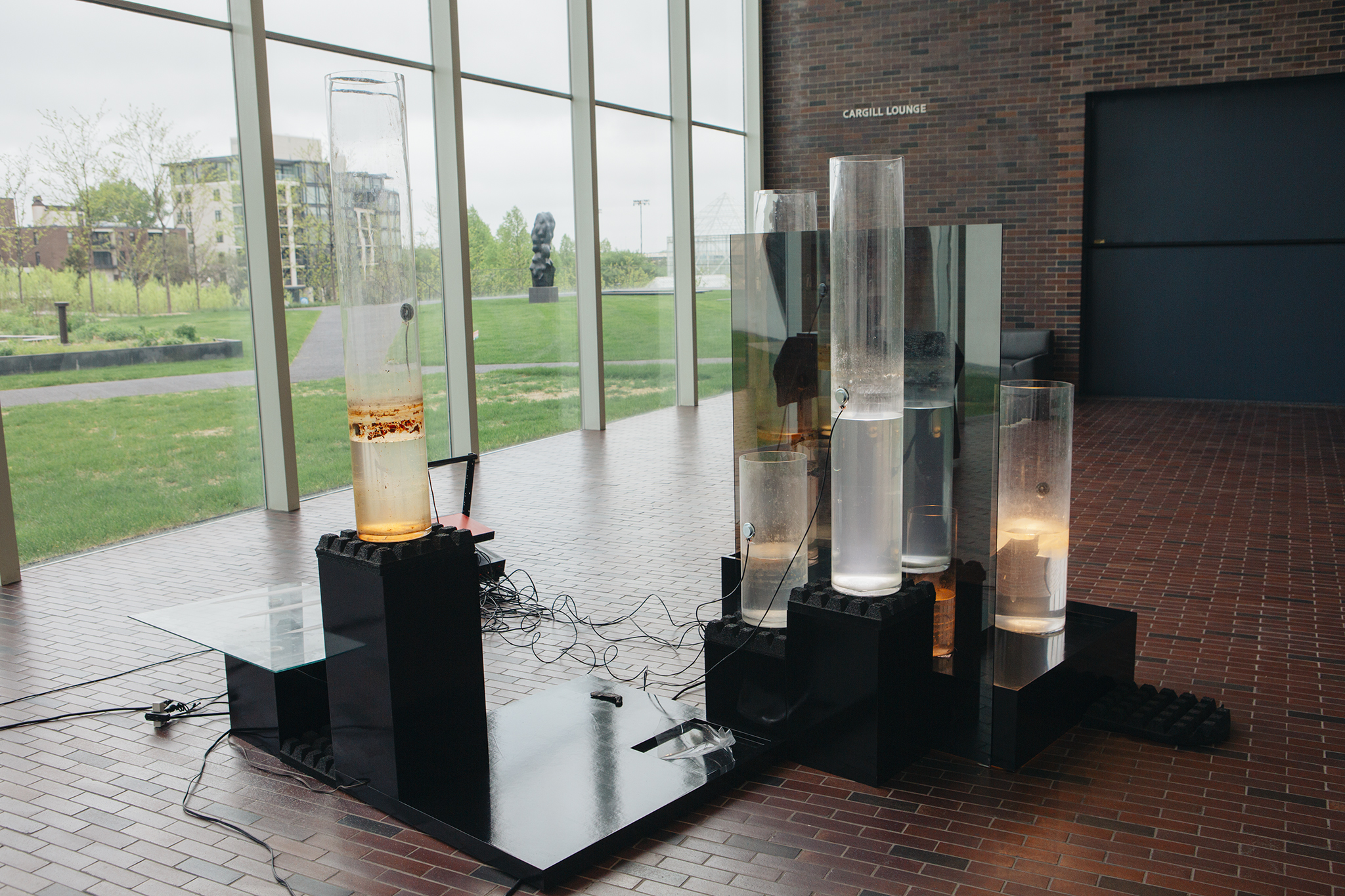
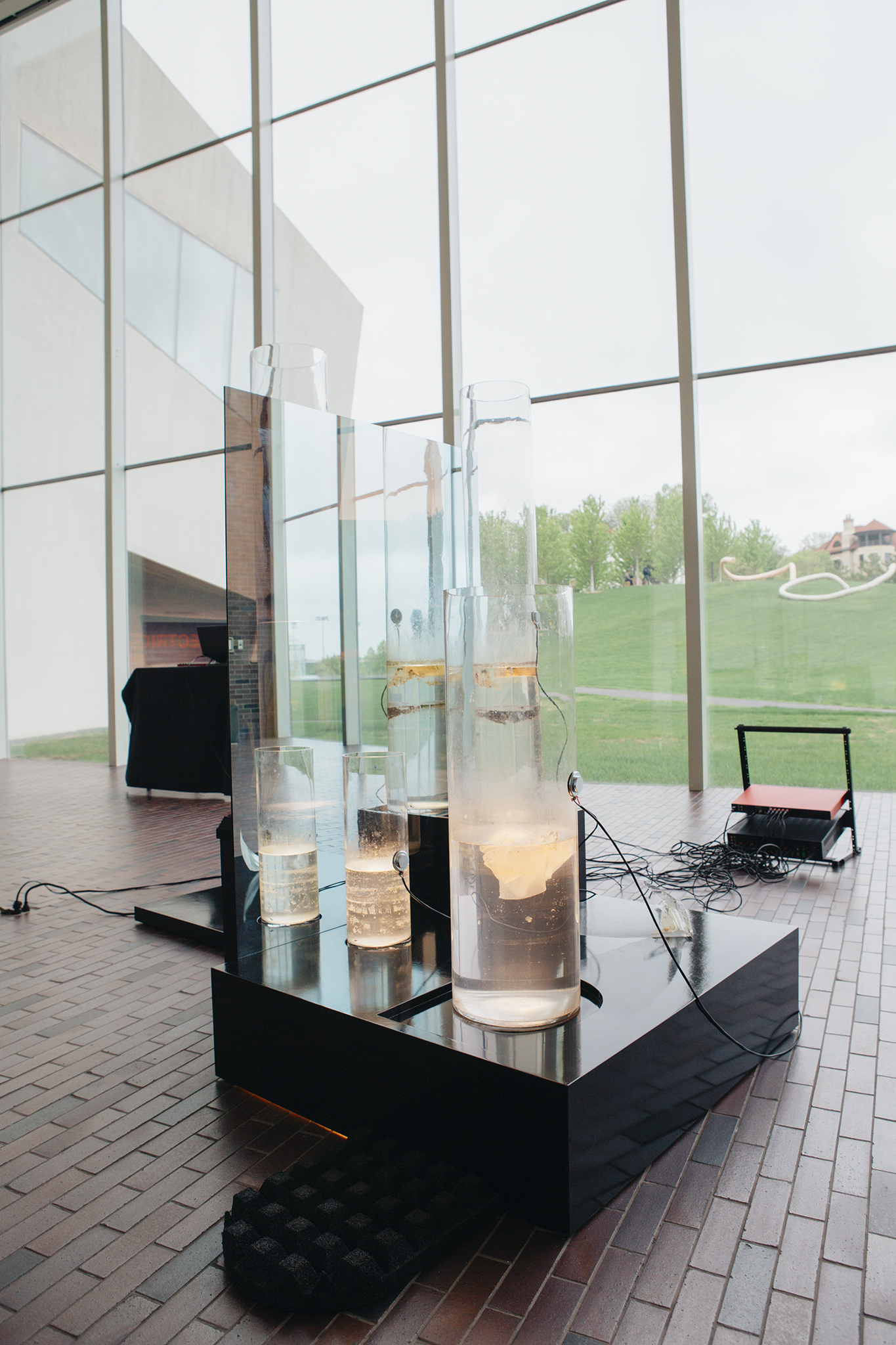
“This whole though is also a hole: the whole individual is emptied out by the very thing that completes it. That is to say, language brings one into consciousness while deflating individuality by forcing it into its network, by making the “song of myself” accountable on the pages of a social text.” – Brandon LaBelle
The Whole is also a Hole is a corporeal resonating sculptural machine that plays, and is played. Comprised of organic matter-filled glass vessels charged and broken by sound, two-way mirrors, and interlocking piano-esque chambers, the piece functions as a performer, instrument, ensemble, and stage. It screams and is also being screamed. The artist’s voice fills The Whole is also a Hole until liquids jump, shake, and release. This piece speaks through the phenomenology of resonance–a set of conditions or relationships between things (bodies, ideas, energy, objects, sounds)–to form a hybrid affect found in the inter-subjective vibrating now
Photo Credit: Malanda Jean-Claude
Dysmorphias Draw A Line
SculptureCenter
In Practice, 2018
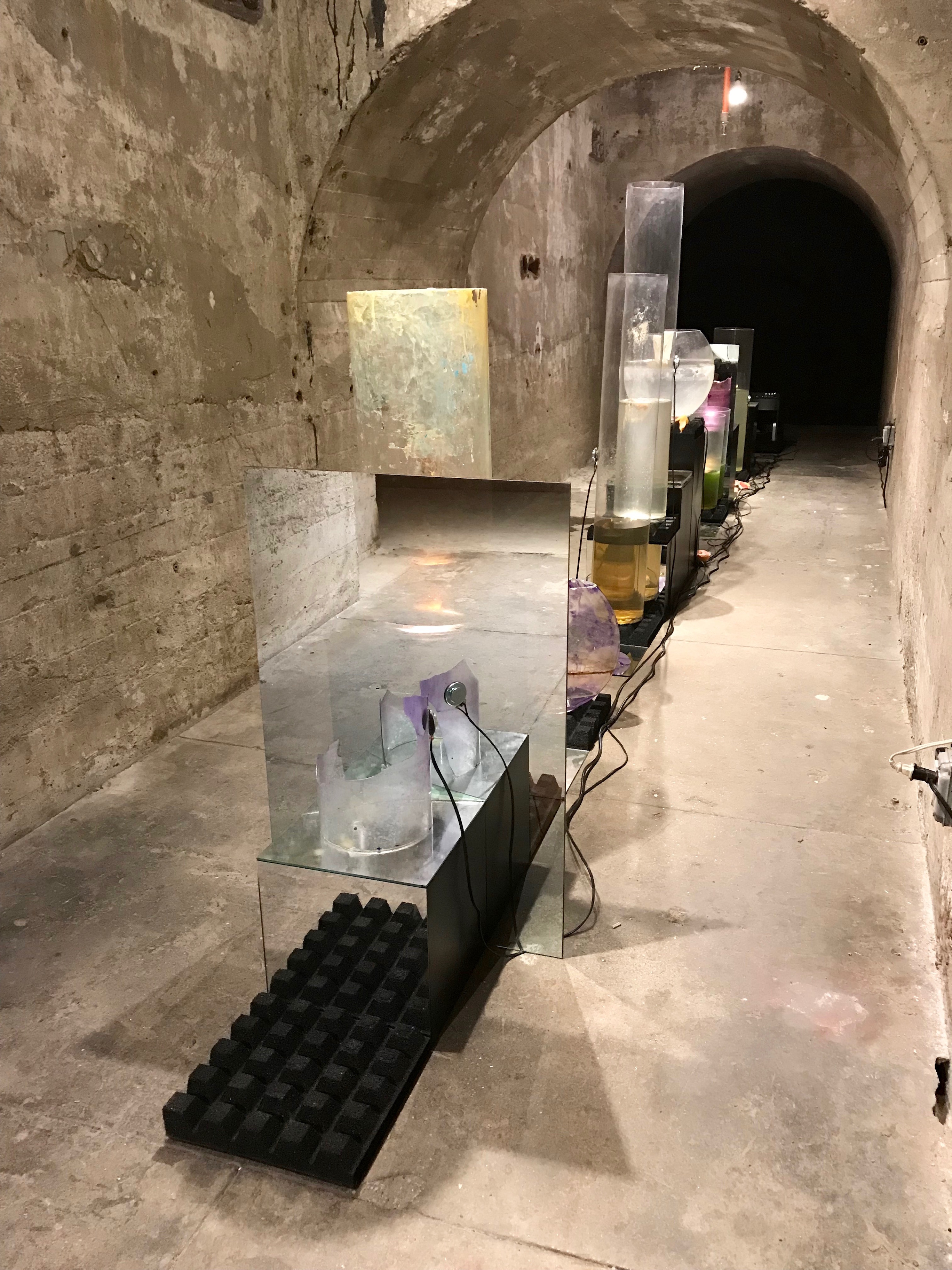
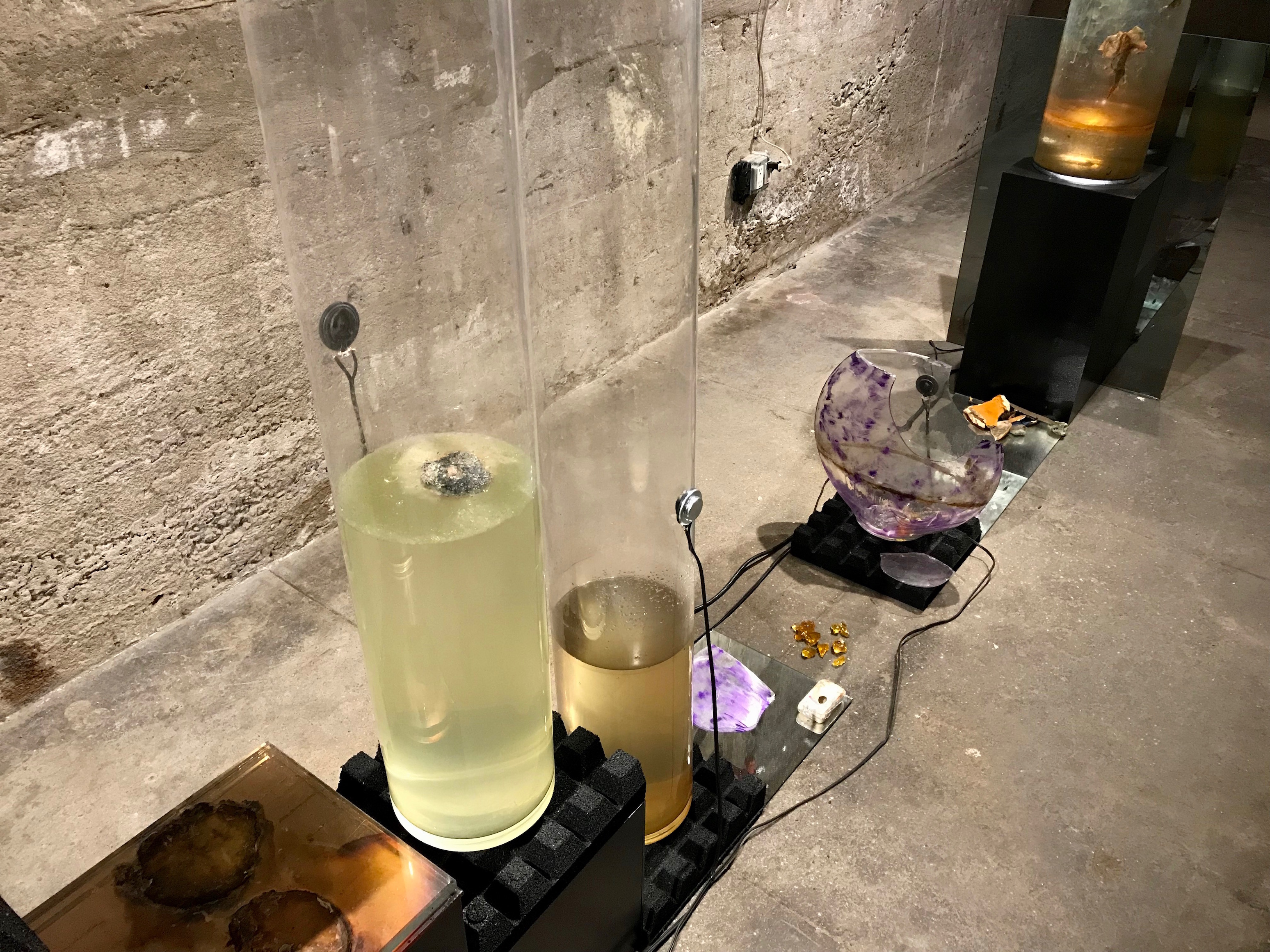
SculptureCenter, In Practice
With Dysmorphias Draw A Line, Jules Gimbrone creates work that asserts the presence of the flexible, nuanced body, in particular, the sounding of queer subjects that are regularly silenced in the public sphere, through an ecology of transmorphic, responsive materials and audio. An ensemble of glass vessels, filled with salt water and detritus (rotting grapefruits, a rusting screw, and mold) placed in a line, act as both instruments and speakers. Gimbrone records intimate dynamics between the resonant glass vessels and a sensitive mic—the feedback as it nears the surface of the glass, the sound of water poured into their interior—as well as their own body: a mic dragged along the hair of a leg, an emanation of voice from inside the mouth, a hum or hiss. At times Gimbrone voices the word bad, drawn out and stretched like the sound of a sheep, disarming the word from its decisive, snap judgement quality—it’s assertion of an either this or that. Gimbrone sounds bad as if to take a POTUS tweet (#verybad) and turn it into a vibratory, wordless emanation. Transducers attached to the vessels let it all playback through the glass—the sound scored to let each play as individuals or to sweep through the line, a transmission across one permeable and peculiar body—queer, our natural state, as Gimbrone believes—in an ecstatic if at times discomforting environment of sonic touch.
Just Stop
Helena Anrather Gallery
Glass Age
2018
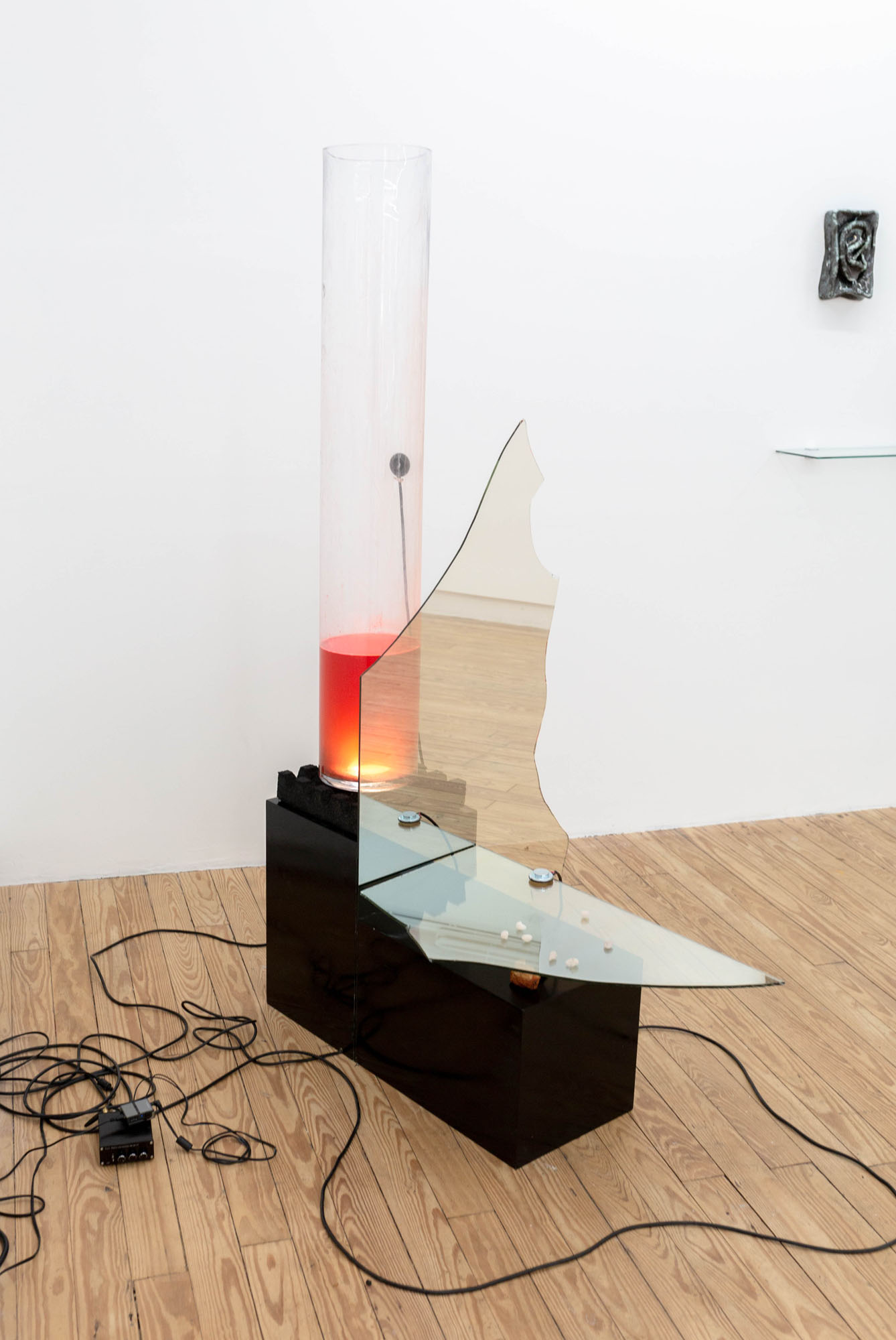
Helena Anrather
Glass Age
2019
Two-way mirror, Glass vessel, Used ear plugs, Dessicated apple, Salt water, Bitters, Tactile Transducers, Electronics, Artist saying “Just Stop”
Surface (Oh, Owe, Ow)
Stellar Projects
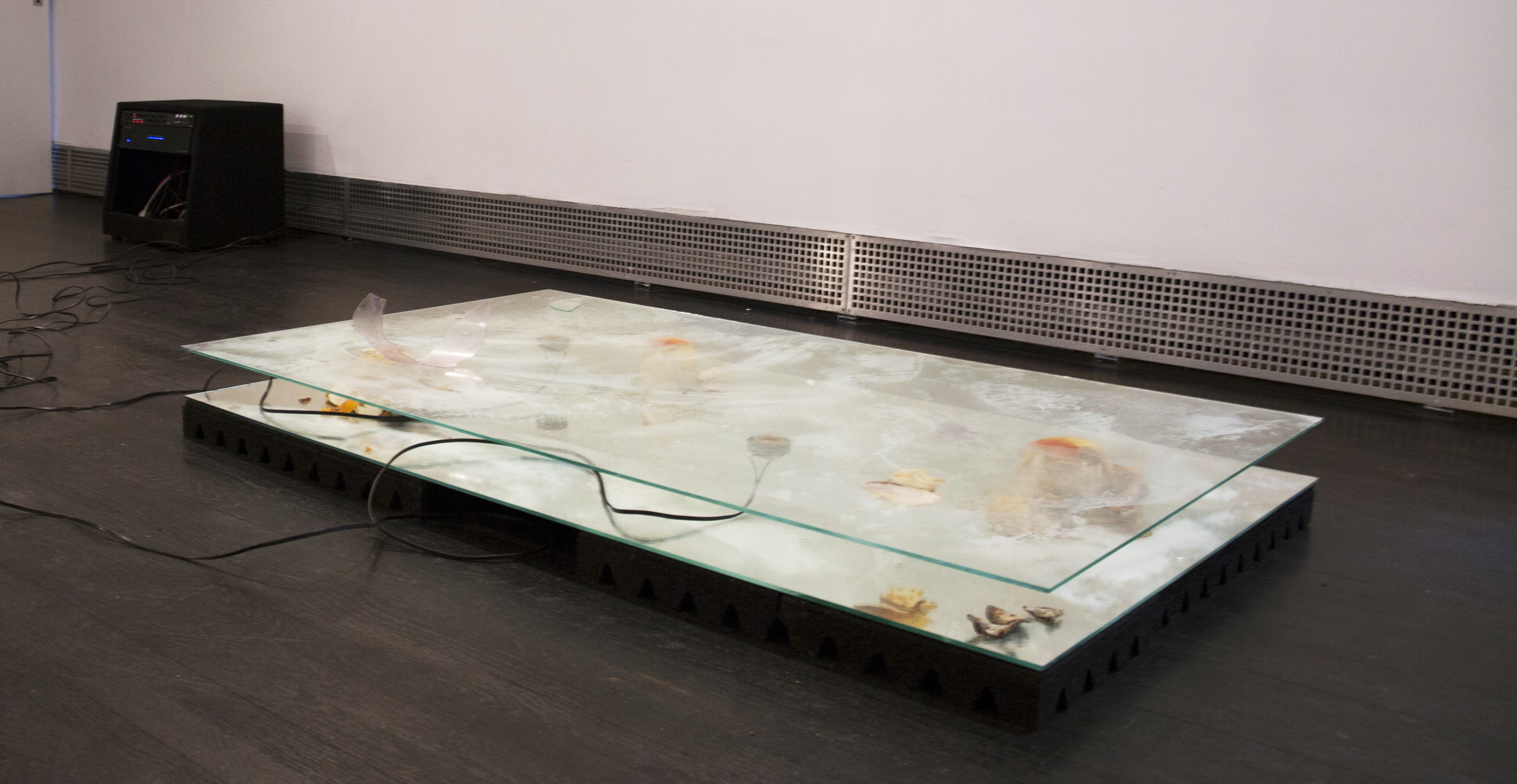
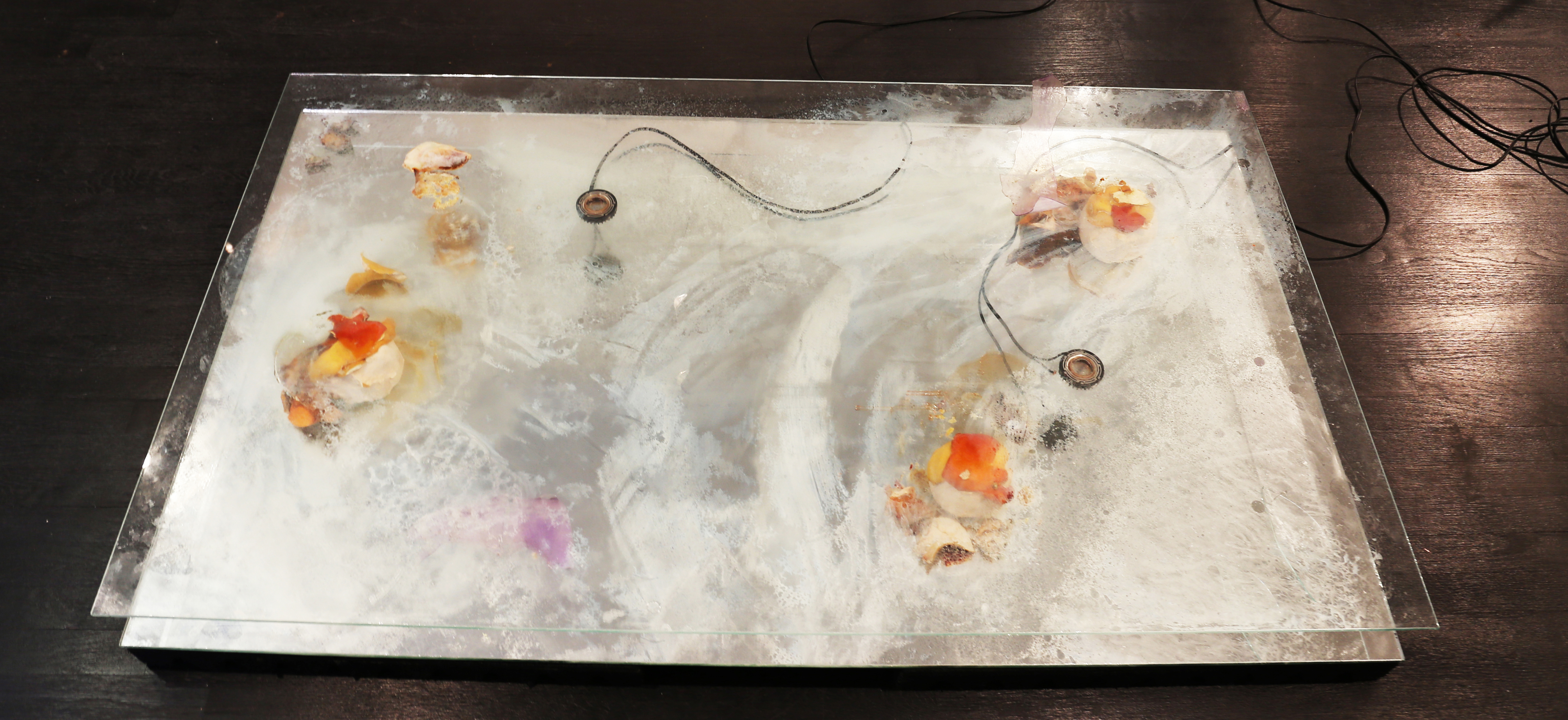
Stellar Projects
For Surface (Oh, Owe, Ow), Jules Gimbrone arranges translucent, bisected, reflective, liquid, and entropic material into ensembles, such as a resonating stage or duet between glass vessels. Each one is studded with transducers that convert audio recordings of the material into vibrations directed back into their sources. The transduction of sound in turn transduces the function of the surface material. Rather than demarcating the boundaries of autonomous objects, they indicate relationships that are pervious, manifold, and in flux. Visually and audibly effected by the sonic transfer, the ensembles become listening bodies that rattle, shatter, ripple, bloom, and evaporate.
Overtones cause a shard of glass to dance skittishly on the salty surface of Thin Spread of a Specific Edge (2018). The glass was lodged deep in the artist’s leg when they were five years old and went undetected by X-ray machines until it rose to the skin one year later. Broken and preserved, sharp and harmless, of the body yet foreign to it, it’s solo act demonstrates both the physical intensity and fundamental permeability of corporeal parameters.
Traps and Transmutations
Park View Gallery
The Social Register
2017
Park View
A 4ft x 4ft resonating platform composed of instruments–4-ft glass vase, desiccated banana, deflated balloon, microphone-encased-in-melting-ice, non-ice-resin-microphone-cubes–is the stage for a performed sound score. Inviting the audience onto the stage, Traps and Transmutations, responds to the changing weight and pressure of these forms through a varied expression of resonating frequencies and overtones. The digital recordings–blowing up a balloon, the artist singing “concave, convex” into the glass vase, a cat purring, “knockings” of the artist’s body against the walls of the gallery, the resonate frequencies of the glass vase and the room of the gallery–transmute (through tactile transducers and bass shakers) these soundings through the platform (low frequencies) and glass vase (high frequencies). The resulting composition point to the mechanism of the recordings themselves–the microphones–and their potential to impose discrete, contained, digitally replicable, representational traps of bodies in space. This relationship is then paralleled to the bounded space of the stage and the finite, but infinitely transmutable, space of the body.
Monomorphic Surfaces (or what I listen for when I listen in Men’s bathrooms)
Full Body

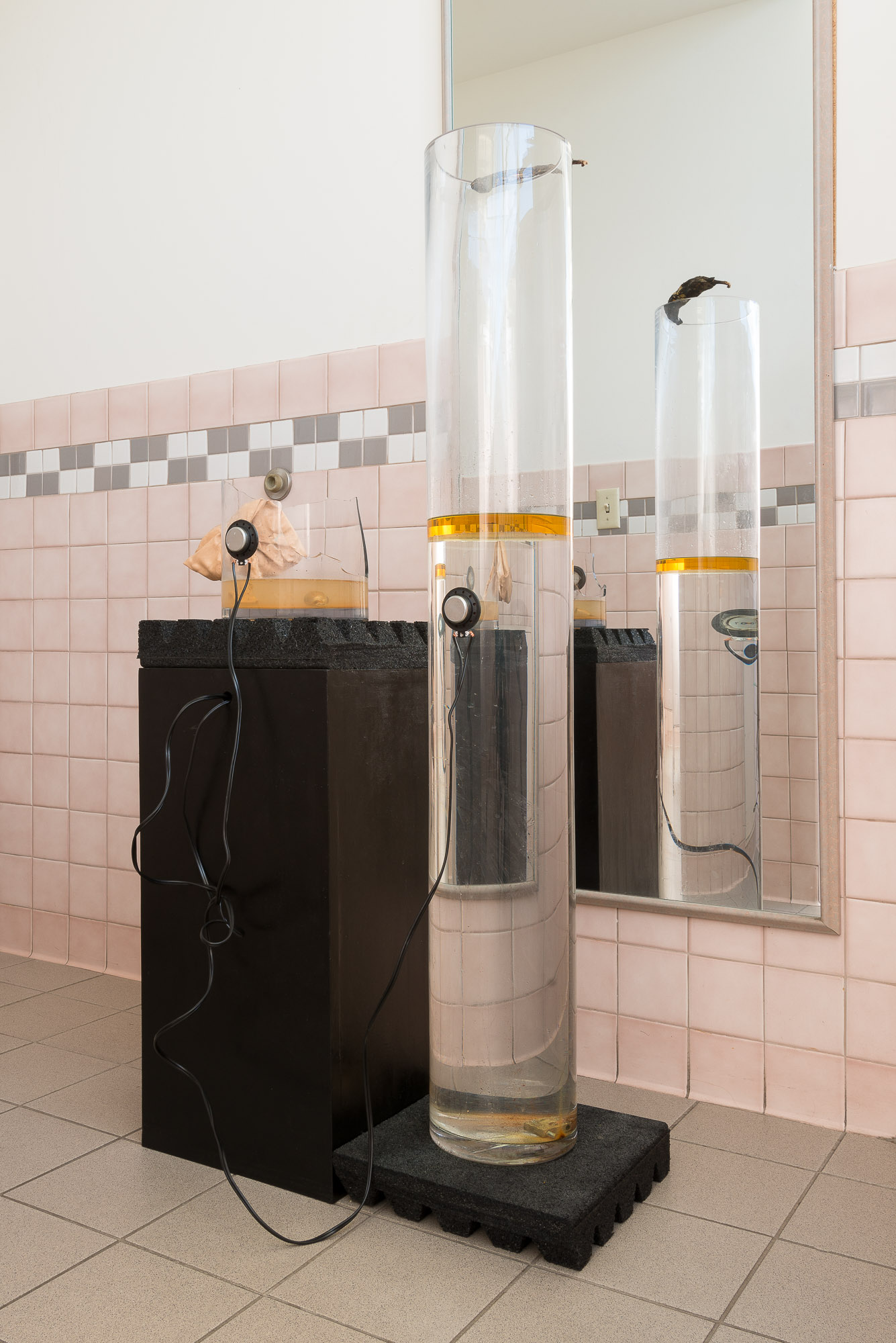
Salt water
Cooking oil
A desiccated banana
A balloon
Water beads
Two brass bells
Recording of piss going into a pot
This vessel is accompanied by another that has been broken.
Jules Gimbrone is an artist and composer that asks how social performance is codified, captured, and transmitted. Using a variety of recording and amplifying technologies—in addition to materials such as clay, ice, and the ambient sound of past performances—Gimbrone investigates how sound travels through space, bodies, and language as a way of exploring hidden or sublimated gendered systems. For Monomorphic Surfaces (or what I listen for when I listen in Men’s bathrooms), the artist considers the differences between male and female anatomy. As a transgender or non binary person, Gimbrone cites the bathroom as a particular space where thoughts and projections regarding these differences, specifically the difference of genitalia, become emphasized in a way that is not felt elsewhere. The concept of biopolitics articulates that these differences, and the materiality of sex in general, are constructs of political and social power structures that attempt to enforce authority over bodies by constricting them to assigned categories, such as gender and sex.*Gimbrone’s vessels exist beyond the confines of their glass walls and continue in the form of their audio hitting our ears and tissues; their conceptual, political, visual, and auditory interpretations; and an infinite number of manifestations as is the case with all bodies. Constructing a piece that purposefully transcends its materiality while also utilizing the sound of urination, one that is homogenous between both gendered restrooms, Gimbrone has created a body that gently eliminates corporeal boundary lines.
Prosody as Messy Measurement Membrane
ISSUE Project Room
Isolated Field Recording Series
2020

Isolated Field Recording Series: Jules Gimbrone – Prosody as Messy Measurement Membrane from ISSUE Project Room on Vimeo.
“There is a membrane, fluid, space, flesh and skin that first creates an apparent separation–inside/outside. The fetus hears the voice of the human through this membrane—the prosody of the language—intonation, tone, stress and rhythm. The musical part of language is what we mimic in our first wails and cries. These beginning vocalizations are sounds we also hear in the languages of animals. Early hominids used, and song birds, primates, and babies use prosody for emotional expression and communicative coordination. Acoustic signaling—pitch level, pitch duration, volume, pausing, intonation, speed, breath—is the primordial vector between ourselves and another. Hello. Get away. I am hungry. I am scared. I want you.
The empirical project of identifying abstractions (identity in general) external to us, naming them, and placing them in discrete quantifiable categories starts with the leap from sounds to verbal language. With words we approximate the truth, and we give discrete measurement for that which had previously been a cacophony of contingent call-and-responses. The word reigns as the supreme tool, measurement, locus of knowledge and power. We turn to words when we are scared of the abstractions, when the world of shadows is descending upon us in order to give structure and order; to make objects. Man. Woman. Black. White.
The ‘field’ in the field recording is the place of this world of shadows. The field is the outside; all that is messy, unknown, external, undefinable, raw, natural, untamed, unknown, influx, permeable, scary, inefficient, loud, and dark. In the field is the monstrous beast that is howling, growling, and tearing a chaotic path.
The ‘recording’ in the field recording is the tool of measurement. The recording mechanism, like a photograph, proclaims to record a type of truth of this outside place. Like most valued tools, it is used like a type of scientific instrument; by extending the capacity of the human ear, the microphone and amplifying device becomes a type of transhuman prosthetic able to survey the ‘field’ for features otherwise unknown.
What is the prosody of the membrane? Instead of putting the measurement in a tool aimed at capturing truth, we listened to the membrane, the window between, as a messy measurement between the field and the hand holding the microphone, the camera, the microscope. We give this membrane a chance to speak, not through words, but through non-verbal affects. An opportunity to articulate the real as a series of abstract relationships between the inside and the outside.” from Prosody as Messy Measurement Membrane, Jules Gimbrone 2020